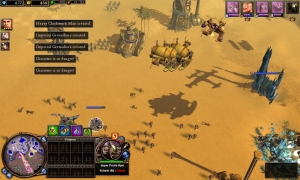I’ve played video games for 21 years. Adventure, rhythm, role-playing, platformer, first-person shooter, and of course strategy – I’ve played virtually every genre, with the notable exception of sports games, at one time or another. But for all that, there is one slight problem.
I’m not actually that great at playing games.
Oh, for platformers and shooters and whatnot*, I have a ready-made excuse: I have poor reflexes and hand-eye coordination. But even when it comes to RPGs and strategy games, if I’m playing single-player, my skill level plateaus out at “pretty good”. I’m not terrible: I’ve won Civilization V on the second-highest difficulty, Immortal (which, according to the Steam achievements page, only 1% of players have done) and I’ve won on the third-highest difficulty, Emperor, with just one city. But you won’t see me recording speedruns, or going for the really extreme self-imposed challenges, such as beating games without using special abilities or researching better weapons. Why?
The surface explanation is very simple. As with anything else in life, learning how to play video games very well takes a lot of work — and for me, that defeats the whole point of playing games. But that can’t be the whole story, because plenty of gamers do take the effort to reach that level of skill, whether it’s by practicing aiming and movement in a shooter or by poring over the equations that govern a strategy game. So again, I have to ask, why?
The answer is that, even when it comes to strategy, I don’t treat games as systems to be mastered; I treat them as stories to be acted out through my decisions. Instead of, say, examining the rules in minute detail, or whipping out a spreadsheet to optimise a character build, I will just opt for choices that seem both cool and intuitively reasonable. Anecdotally, I’m not alone in this, judging by the number of other people who also like to play as “builders” in the Civilization series (which, to my knowledge, has historically rewarded rushing on higher difficulty levels). And once I realized this, several game design choices fell into place for me.
Consider the use of shooter mechanics in RPGs such as Mass Effect and Fallout 3. Which is more intuitive: using elaborate D&D rules, as in the case of Neverwinter Nights, or “hide behind cover, aim gun at target, fire gun”? Seen in this light, Bioware’s choice to make Mass Effect 2 (which I haven’t played but which I have read about) an action-RPG, streamlining away traditional RPG elements in the process, makes sense as a way to take the game further down the “intuitive” path.
Meanwhile, in the strategy space, the Total War games are the poster child of intuitive game design. The visually splendid way they present combat, with lovingly detailed armies of 3D soldiers marching and swinging their swords, isn’t just a way to bamboozle players into not noticing bad AI – it allows us to play using common sense. When I can see a line of heavily armoured knights galloping toward a clump of men on foot with their backs turned, I don’t have to look up a rulebook to predict what’ll happen next. And I think that is a major part of the series’ appeal.
Intuitive gameplay is harder to deliver in some settings than in others. The classic example is science fiction: in Civilization, it’s not hard to guess what inventing the wheel, or the concept of chivalry, or gunpowder, will give me. In a science fiction game, on the other hand, how would I instinctively know what “moleculartronics” is good for? As a result, I think science fiction games can’t afford to leave details under the hood: one of my complaints with Sword of the Stars, the space opera 4X game from Kerberos, was how uninformative the game was. Determining how exactly a cruiser equipped with “meson cannons” would fare against one with a “particle beam” was the exact opposite of my earlier example of the knights and infantry.
Does intuitive gameplay mean there’s no element of skill? Of course it doesn’t. Returning to Total War as an example, there’s still skill involved in planning a campaign, deploying and manoeuvring troops, timing a charge, and so on. But it does mean that, again, a player can generally rely on common sense and “generalist” skills, such as the ability to assess the situation on a map and then choose the appropriate terrain to make a stand, rather than on deeply game/ruleset-specific skills.
As a game design goal, then, “intuitive” gameplay is a worthy one. It makes learning curves less intimidating, and it helps gamers like me have fun: we can play to win at the same time that we create stories from our gameplay experiences. After all, “I swung my knights around and rolled up his line!” is a much more exciting tale than, “I applied a +2 modifier to my knights, then multiplied it by 1.5x, at the same time he was suffering from a 15% penalty!” It’s not for everyone or for every genre, but it’s still something that belongs in a designer’s toolkit. And it helps explain the appeal of many games, such as Total War, that can’t just be explained away by “ooh, look at the pretty graphics”.
Returning to the original question of my skill: am I any better at intuitive games than I am at their fiddlier, crunchier brethren? Probably not, but at least I can pretend I am…
* These are the genres at the “Action” spectrum of the Escapist magazine’s genre wheel, which I discussed a while back.








